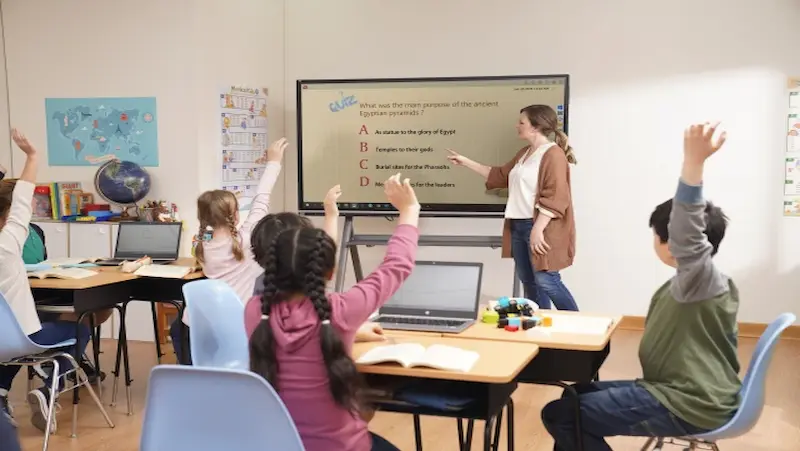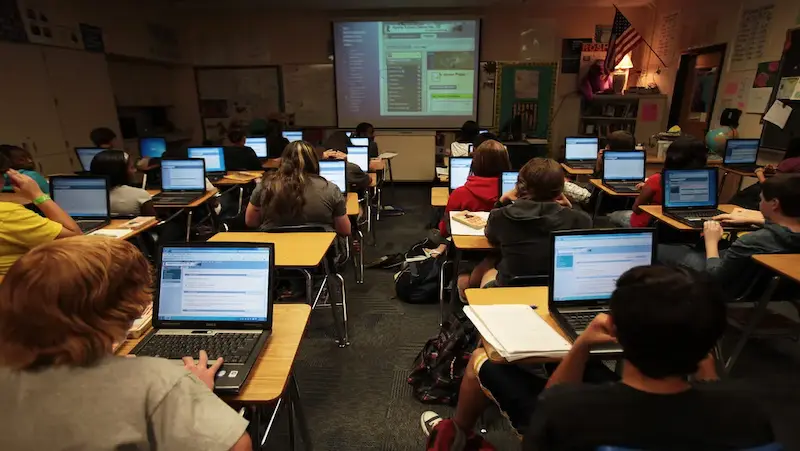High school education in the United States holds a pivotal place in shaping the future of its students. Beyond being a compulsory phase of academic life, it serves as a transformative period where young minds acquire knowledge, skills, and values that lay the foundation for their adult lives.
This crucial educational stage not only equips students with academic expertise but also fosters personal growth, and social development, and prepares them to navigate the challenges of the real world. In this discussion, we will delve into the multifaceted importance of high school education in the USA, highlighting its enduring impact on individuals and society as a whole.
Table of contents
Structure of High Schools
High schools serve as the bridge between adolescence and adulthood, offering a dynamic and diverse educational experience. Understanding their structure is crucial for students, parents, and educators alike. In this section, we’ll delve into the key aspects of high school education structure.

Grade Levels and Age Groups
High schools typically encompass grades 9 through 12 in the United States, with students typically ranging from 14 to 18 years old. This period marks a crucial stage of personal and academic development. As students progress through these four years, they acquire knowledge, skills, and life experiences that prepare them for the challenges of adulthood.
1. Freshman (Grade 9): Freshmen are often new to the high school education environment, adjusting to increased academic rigor and greater independence. They lay the foundation for their high school journey, exploring a variety of subjects and extracurricular activities.
2. Sophomore (Grade 10): Sophomores continue to build their academic foundation, often taking more challenging courses and considering their long-term goals. They may also participate in career exploration activities for kids.
3. Junior (Grade 11): Junior year is a pivotal time for students as they start thinking seriously about post-graduation plans, including college or career pathways. This year often involves standardized tests like the SAT or ACT.
4. Senior (Grade 12): Seniors are at the pinnacle of their high school education journey, focusing on college applications, and scholarships, and finalizing their academic achievements. It’s a time of excitement and anticipation for the next chapter in life.
Types of High Schools (Public vs. Private)
High schools can be categorized into two primary types: public and private.
1. Public High Schools: Public high schools are funded and operated by local government authorities. They are typically tuition-free and open to all students in the designated school district. Public schools often have larger student populations, and diverse offerings, and are subject to state curriculum standards. They play a vital role in providing education to a broad spectrum of students, regardless of their background or financial status.
2. Private High Schools: Private high schools, on the other hand, are independently funded and managed. They may be affiliated with religious organizations or have specific educational philosophies. Private schools often charge tuition, which can vary widely, and they have more flexibility in curriculum design and extracurricular programs. These schools can provide a more tailored and specialized education experience.
High School Curriculum

Core Subjects
1. English and Literature
English and literature are the cornerstone of a high school curriculum. These subjects not only teach us how to communicate effectively but also immerse us in the rich tapestry of human stories and ideas. Through the study of classic literature, students gain insights into different cultures, time periods, and perspectives, fostering empathy and critical thinking.
2. Mathematics
Mathematics, often regarded as the universal language, equips students with problem-solving skills that are indispensable in everyday life and various careers. From algebra to calculus, high school mathematics challenges students to think logically and abstractly, preparing them for the analytical demands of the modern world.
3. Science
Science for kids in high school explores the wonders of the natural world. Through biology, chemistry, physics, and other scientific disciplines, students learn to observe, hypothesize, and experiment. These skills not only deepen our understanding of the world but also lay the foundation for future scientific discoveries.
4. Social Studies
Social studies encompass a wide range of subjects, from history and geography to economics and civics. These courses help students comprehend the complexities of human societies and the interconnectedness of global issues. Studying social studies fosters informed citizenship and a sense of responsibility to our communities and the world.
Elective Courses
1. Fine Arts
Fine arts courses, such as visual arts, music, and theater, provide a creative outlet for students. Beyond self-expression, they cultivate skills in critical thinking, problem-solving, and teamwork. Fine art for kids enriches the high school experience by encouraging students to appreciate beauty and embrace diversity in artistic expression.
2. Physical Education
Physical education is crucial for promoting physical health and well-being. It teaches students the importance of an active lifestyle, teamwork, and discipline. Beyond the physical benefits, it instills lifelong habits that contribute to a healthier, happier life.
3. Career and Technical Education
Career and Technical Education (CTE) programs offer students opportunities to explore potential career paths and gain practical skills. Whether it’s automotive repair, culinary arts, or computer programming, CTE equips students with the knowledge and abilities needed to excel in specific fields and make informed career choices.
Advanced Placement (AP) and Honors Programs
For students seeking academic challenges beyond the standard curriculum, high schools often offer Advanced Placement (AP) and honors programs. These rigorous courses delve deeper into core subjects, preparing students for college-level coursework and offering the opportunity to earn college credit. AP and honors programs are designed to foster intellectual curiosity and provide a competitive edge in the pursuit of higher education.
Teaching Methods and Pedagogies

Traditional Classroom Instruction
The traditional classroom setup has been the cornerstone of education for centuries. It’s a familiar sight – students seated in rows, a teacher at the front, chalkboard or whiteboard, and face-to-face interaction. This method fosters a sense of community, provides immediate feedback, and allows for in-depth discussions.
One of its main advantages is the personal connection between teachers and students, which can be a powerful motivator. Traditional classrooms encourage active participation, teamwork, and critical thinking. However, they may lack flexibility and struggle to adapt to individual learning paces.
Online Learning and Blended Learning
Online learning has transformed education, making it more accessible and flexible. Whether you’re pursuing a degree or learning a new skill, the internet offers a vast array of resources. It caters to diverse needs, from self-paced courses to live virtual classrooms.
Blended learning combines the best of both worlds – traditional and online methods. Students can access course materials online, allowing for flexibility in scheduling and location. Then, they attend face-to-face classes or engage in virtual discussions, combining the benefits of personal interaction with the advantages of digital resources.
Innovative Teaching Approaches
Innovation in education is a driving force for change. Educators are constantly exploring creative ways to engage students and enhance learning outcomes. Project-based learning, flipped classrooms, and gamification are just a few examples of innovative approaches.
Project-based learning encourages students to apply what they’ve learned to real-world problems, fostering critical thinking and problem-solving skills. Flipped classrooms reverse the traditional learning model, with students reviewing content independently and using class time for active discussions and projects. Gamification uses game elements to make learning games for kids more engaging and enjoyable.
Challenges in High School Education

Achievement Gap and Educational Inequality
One of the foremost challenges in high school education is the persistent achievement gap and educational inequality. Despite efforts to bridge the gap, disparities in access to quality education and resources persist. Students from disadvantaged backgrounds often face an uphill battle in terms of academic performance and opportunities. Addressing this issue requires a multifaceted approach, including equitable funding, mentorship programs, and inclusive curricula.
Bullying and School Violence
Bullying and school violence are sobering issues that affect students’ physical and emotional well-being. The prevalence of bullying, both in-person and online, can lead to long-lasting trauma and hinder the learning environment. Schools must prioritize creating safe, welcoming spaces through anti-bullying programs, counseling services, and clear reporting mechanisms. It’s crucial to foster a culture of empathy and respect among students to combat this challenge effectively.
Mental Health and Stress Among Students
High school can be an incredibly stressful time for students. The pressure to excel academically, coupled with extracurricular activities and social expectations, can take a toll on mental health. Depression, anxiety, and burnout are all too common among high school students. Schools need to invest in mental health resources, such as counseling and stress management programs, to help students cope with these challenges and ensure they have the support they need to thrive.
The Role of Teachers

Teacher Qualifications and Training
When it comes to education, the qualifications and training of teachers are of paramount importance. High school educators must possess a strong educational background and relevant certifications in their respective subjects. But it’s not just about degrees; it’s also about continuous professional development.
Teachers need to stay up-to-date with the latest teaching methods and educational technologies. They should be well-versed in the evolving needs of their students, adapting their teaching strategies accordingly. In essence, teacher qualifications and training are the foundation upon which a robust education system is built.
Teacher-Student Relationships
The connection between teachers and students is a cornerstone of effective education. A positive teacher-student relationship fosters trust, respect, and an environment where learning can thrive. It’s not just about imparting knowledge; it’s about understanding the unique needs and challenges each student faces.
Teachers who take the time to connect with their students on a personal level can inspire a lifelong love for learning. They provide emotional support, guidance, and encouragement, helping students navigate the complexities of high school and beyond. These relationships often extend beyond the classroom and can leave a lasting impact on a student’s life.
Challenges Faced by High School Teachers
Teaching at the high school level comes with its own set of challenges. From managing diverse classrooms to addressing the individual learning needs of students, high school teachers have their work cut out for them. The challenges they face include:
1. Diversity: High school classrooms are often a melting pot of diverse backgrounds, abilities, and learning styles. Teachers must create an inclusive environment that caters to every student’s needs.
2. Technology Integration: Embracing technology in education is crucial, but it can be overwhelming for teachers who may not be tech-savvy. Navigating digital tools and ensuring their effective use can be challenging.
3. Mental Health: The mental well-being of students is a growing concern. High school teachers often find themselves in the role of not just educators but also counselors, helping students cope with stress and emotional issues.
4. Standardized Testing: The pressure of standardized testing can be daunting for both teachers and students. Teachers must strike a balance between preparing students for these assessments and providing a holistic education.
Technology in High School Education

Integration of Technology in Classrooms
Gone are the days of dusty chalkboards and overhead projectors as high schools increasingly adopt technology as a fundamental part of their curriculum. Smartboards, tablets, and laptops have become essential tools, empowering both teachers and students to explore the vast landscape of knowledge in dynamic, interactive ways. These tools foster engagement, making learning a more immersive and enjoyable experience.
Benefits of EdTech
Personalized Learning: Technology enables tailored learning experiences. Adaptive software and online platforms can adjust content and pacing to match individual student needs, ensuring no one is left behind.
1. Access to Resources: The internet brings the world’s knowledge to students’ fingertips. From educational videos for kids to virtual field trips, the resources available online expand the boundaries of traditional textbooks.
2. Collaboration: EdTech facilitates collaborative learning, allowing students to work together on projects, share ideas, and engage in discussions regardless of physical proximity.
3. Preparation for the Future: In a world driven by technology, equipping students with digital skills and digital literacy is crucial for their future success, making them more competitive in the job market.
Concerns of EdTech
1. Screen Time: Excessive screen time can lead to health issues like eye strain and reduced physical activity. Striking a balance between digital and offline activities is essential.
2. Privacy and Security: Protecting students’ data and online privacy is a paramount concern. Schools must implement robust security measures and educate students about safe online practices.
3. Equity: Not all students have equal access to technology at home, creating a digital divide. Schools must ensure that all students have access to the necessary devices and internet connectivity.
Parental Involvement

Parental Involvement: A Cornerstone of Success
In the journey of a child’s education, one factor stands out as a game-changer: parental involvement. When parents actively participate in their children’s learning, it can make all the difference in their academic success and personal development. Let’s explore the importance of parental support, the role of Parent-Teacher Associations (PTAs), and some of the challenges that parents face when getting involved.
The Importance of Parental Support
Parents are a child’s first and most influential teachers. Their involvement in a child’s education goes beyond helping with homework; it sets the foundation for lifelong learning. When parents engage in their children’s educational journey, they show them that learning is valuable and worth investing in. This support boosts children’s confidence, motivation, and overall academic performance.
Parent-Teacher Associations (PTAs)
PTAs are a vital link between parents and schools. They offer a platform for parents to actively participate in school activities, communicate with teachers, and shape the educational games for kids experience of their children. PTAs organize meetings, fundraisers, and events that enhance the school community.
Through PTAs, parents can voice their concerns, contribute to school improvements, and collaborate with educators to ensure that the educational environment is conducive to learning. These associations are a powerful way for parents to collectively make positive affirmations for kids impact on their children’s education.
Challenges in Parental Involvement
Despite the numerous benefits of parental involvement, it’s not always easy for parents to engage actively. Challenges such as busy work schedules, language barriers, and lack of familiarity with the education system can hinder their participation. Additionally, some parents may feel intimidated or unwelcome in school settings.
To overcome these challenges, schools can work on creating a welcoming and inclusive atmosphere, providing resources and information in multiple languages, and offering flexible opportunities for involvement, such as virtual meetings and workshops.
Conclusion
In conclusion, our exploration of high school education in the USA has shed light on both the strengths and challenges within the system. While we’ve seen dedicated educators and a diverse range of opportunities for students, we’ve also recognized disparities and room for improvement.
It’s evident that a continued commitment to equitable access to quality education, innovative teaching methods, and a nurturing environment will be vital in shaping the future of American high schools. With collaborative efforts from educators, policymakers, and communities, we can strive for an educational landscape that empowers every student to reach their full potential.
To get your hands on more such articles, educational content, and free resources on coding for kids, robotics courses, game development, etc., check out the BrightCHAMPS Blog Page now!
Frequently Asked Questions
A1. High school students in the USA typically range in age from 14 to 18 years old.
A2. Public high schools are funded by the government and open to all students, while private high schools are independently funded and may have selective admissions criteria.
A3. High school students often face challenges like academic pressure, social issues, and mental health concerns.
A4. Parents can get involved by attending parent-teacher conferences, joining the PTA, and staying informed about their child’s progress.
A5. Standardized tests like the SAT or ACT are used by colleges as one of many factors in the admissions process to assess a student’s academic readiness.
A6. Innovations include personalized learning, online classes, and project-based learning to cater to diverse student needs and interests.
A7. High schools can promote inclusivity through diversity training, inclusive curricula, and creating a welcoming environment for all students.
A8. Technology has transformed high school education by enabling online learning, interactive digital resources, and improving access to information.


 We are an army of educators and passionate learners from BrightChamps family, committed to providing free learning resources to kids, parents & students.
We are an army of educators and passionate learners from BrightChamps family, committed to providing free learning resources to kids, parents & students.














